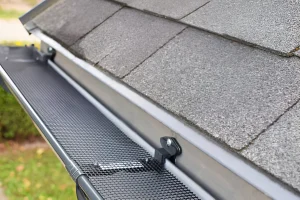Gutter maintenance often only gets attention when a problem arises, even though it should be part of regular home upkeep. One of the most common issues with gutters is clogs, which lead to water overflow, damage to the home’s foundation, and costly repairs. As beautiful and beneficial to the environment as trees are, they are one of the main culprits when it comes to gutter clogs. Different tree species will impact your gutter system differently, so understanding the differences can help you take proactive steps to avoid these issues.
With this post, we will educate homeowners on how specific trees contribute to gutter clogging and how to address these challenges with tailored solutions.
How Tree Types Affect Gutter Clogging
Let’s first examine some of the most common tree types that can clog gutters.
Pine Trees
Pine trees and their needles pose a unique challenge compared to the broad leaves of other tree species. These small needles can easily slip through most gutter guards, making them a common cause of gutter blockages. Pine needles can accumulate quickly, especially if you live in an area with dense pine forests, and can form dense clogs that can be very challenging to remove. Due to their small size, they can lodge in downspouts, which can lead to blockages that can cause water to back up and overflow.
Oak Trees
Oak trees are a challenge of their own with their broad leaves and acorns. During fall, oak trees shed a significant amount of leaves, which can easily clog gutters. Their acorns can cause severe blockages, especially in downspouts. The combination of large leaves and acorns can lead to significant water overflow, which can damage the roof, siding, and foundation if not promptly addressed.
Maple Trees
Maple trees are known for their smaller, more delicate leaves and seeds, commonly called “helicopters,” and present yet another unique challenge. These smaller pieces can quickly fill gutters and downspouts, leading to blockages that require frequent cleaning. Maple seeds, in particular, are notorious for clogging gutters, as they can become compacted and difficult to remove.
Other Notable Tree Types
Of course, these three tree types are not the only ones that can cause havoc in your gutters. Other species like birch, elm, and willow can also impact your gutters. Birch trees shed small leaves that can quickly accumulate, while elms drop larger leaves that can cause blockages. With their long, slender leaves, willows can create a mat of debris that easily clogs gutters and downspouts.
Common Gutter Clogging Scenarios by Tree Type
Scenario 1: Dense Pine Forests
Homes surrounded by dense pine forests face the constant challenge of needlefall. Due to their small size, pine needles can bypass many gutter guards and accumulate quickly, requiring frequent maintenance to prevent blockages.
If you live in such an area, implement a regular gutter cleaning schedule, especially during fall when pine trees shed the most. Also, consider installing fine-mesh gutter guards specifically designed to filter out small debris like pine needles.
Scenario 2: Suburban Areas with Mature Oaks
Many suburban areas have mature oak trees, so their heavy leaf fall and acorn accumulation during autumn can create significant challenges for homeowners. Oak leaves and acorns can quickly clog gutters, which can lead to water overflow and potential damage to the home’s exterior and foundation.
To prevent that from happening, install durable, professionally installed gutter guards equipped to handle the load of large leaves and acorns. Regular gutter inspections and cleanings can help prevent clogs, especially during fall.
Scenario 3: Mixed Tree Landscapes
If your home is located in an area with a variety of tree species, you may face a combination of challenges. Different types of debris, from small pine needles to large oak leaves, can accumulate in your gutters, making it difficult to maintain a clear drainage system.
Living in a mixed tree area, we recommend using versatile gutter guards that can handle both small and large debris. Your maintenance schedule should be adjusted based on which times of the year the different tree species shed the most.
Best Gutter Guard Designs for Different Tree Types
Now that we have identified the challenges of different tree types, let’s see which gutter guard designs are best to tackle the challenges these trees bring with them.
Micro-Mesh Gutter Guards
- Ideal for:Pine needles and small debris from trees like maple.
- Pros:Highly effective at filtering small particles, preventing them from clogging the gutters and downspouts.
- Cons:May require more frequent cleaning as small debris can still accumulate on top of the mesh, especially in areas with heavy needle fall.
Reverse Curve Gutter Guards
- Ideal for:Large leaves from trees like oak and maple.
- Pros:Designed to deflect large debris while allowing water to flow freely into the gutter.
- Cons:May not be as effective against smaller debris like pine needles, which can still enter the gutter system.
Brush Gutter Guards
- Ideal for:Minimal leaf debris or mixed environments with moderate debris accumulation.
- Pros:Easy to install and maintain, these guards are a good option for areas with a mix of small and large debris.
- Cons:Less effective in areas with heavy debris, as the brushes can become clogged and require regular cleaning.
Maintenance Tips for Gutter Protection
Regular gutter cleaning is a must, regardless of which tree types you have around you. However, the frequency of gutter cleaning largely depends on the types of trees surrounding your home. For example, homes near pine forests may require more frequent cleanings due to the continuous shedding of needles. In contrast, homes near oak or maple trees may need more attention during the fall when leaves and seeds are most likely to clog gutters.
Typically, fall is the most critical time for gutter maintenance, as many trees shed their leaves. However, spring is also essential, as trees may shed seeds or small leaves. Focusing on these seasons can reduce the risk of clogs and water damage.
While regular cleaning is essential, professional inspection and maintenance can ensure that your gutters and gutter guards are functioning correctly. On top of that, professionals can also identify potential issues, such as damaged gutters or poorly installed guards, and provide solutions before they become significant problems.
Protect Your Gutters With EavesArmour Gutter Guards
As you can see, different types of trees pose different challenges, impacting the frequency and type of gutter maintenance you’ll need. Pine needles, oak leaves, and maple seeds all present unique challenges you must address through the appropriate gutter guards and regular maintenance. Choosing the right gutter guards can protect your home from potentially costly repairs caused by clogged gutters.
If you’re looking for high-quality gutter guard solutions tailored to your needs, look no further than EavesArmour Gutter Guard. Our all-season protection system ensures clog-free gutters for life, with a discreet and low-profile gutter system design that works on all roof and gutter systems. And with our lifetime transferable warranty, you can rest easy knowing your home is protected. Don’t wait any longer to upgrade your gutter system. Experience the peace of mind that comes with EavesArmour today.
EavesArmour also offers professional gutter cleaning to save you time and money and help prolong the life of your home’s gutters. With over ten years of professional experience, EavesArmour is your partner for gutter maintenance. Call today at 647-931-0441 or fill outour convenient online formto learn more about our services and how we can safeguard your home against gutter-related issues. Trust EavesArmour for professional gutter guard installation and all your gutter needs, and enjoy peace of mind knowing that your home is well-protected.




